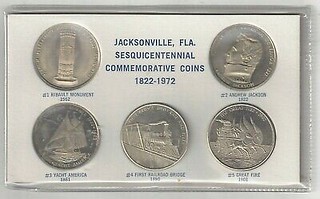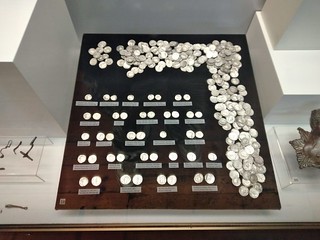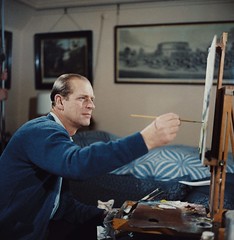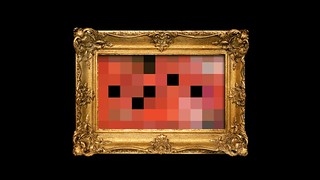
PREV ARTICLE
NEXT ARTICLE
FULL ISSUE
PREV FULL ISSUE
NOTES FROM E-SYLUM READERS: APRIL 11, 2021More on Those Love Tokens on Counterfeit Quarters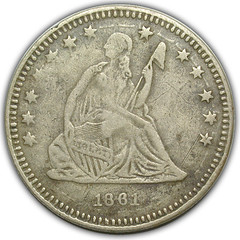
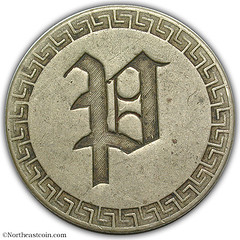
Regarding Jeremy Bostwick's article on the Love Token on counterfeit 1861 Seated Liberty Quarters, Tom Caldwell of Northeast Numismatics writes: Of the examples presented ours seems to be the only one that was not used as jewelry. Guessing other letters of the alphabet will show up. The explanation of it being a cottage industry makes a lot of sense." Thanks for passing along the original item. Interesting story! -Editor
To read the earlier E-Sylum articles, see:
Dennis Tucker of Whitman Publishing writes: "There's a surge in numismatic book sales of late. We've already sold out the first print run of the Continental Currency book, as well as the 2nd edition of the Guide Book of Gold Eagle Coins and the Check List and Record Book of United States and Canadian Coins. Americans seem to be getting back to the classic hobbies, much as we did during the Great Depression." That's great news. I'm glad to hear the boost in hobby activity hasn't left book sales behind. It's a good sign of the continued numismatic renaissance that coincided with the pandemic. Here are a couple notes from Dick Hanscom on the March 28th issue that I didn't manage to get in last time. -Editor Dick writes: "Back in the late 70s, early 80s, I purchased four souvenir ashtray dies: On the White Pass & Yukon Railway, harbor view of Skagway, White Horse Rapids and Alaskan Express (dog team). All designs were taken from post cards circa 1910-1920). I sent all of these dies Medallic Arts Co. to use in making 3 inch, uniface bronze medals. On the last one, Alaskan Express, I had a process set made (maybe 2 or 3). Sadly, when Medallic Arts went bankrupt (the first time), I lost the White Pass & Yukon die. I am in contact with the American Numismatic Society in hopes of recovering it." Good luck with your quest! -Editor
To read the earlier E-Sylum article, see:
Dick adds:
Thanks. Sounds like a good starting point. Dick's excellent newsletter is the Alaskan Token Collector and Polar Numismatist . Note that earlier researcher Sheldon Banoff had contacted the company and was told they hadn't retained records and couldn't help with research requests. -Editor
To read the earlier E-Sylum article, see:
Lianna Spurrier passed along an example of her editing magic in making the faked version of the Drowne letter shown in the NNP April Fools video about "new evidence" on the origins of the Continental Dollar. Thanks! -Editor 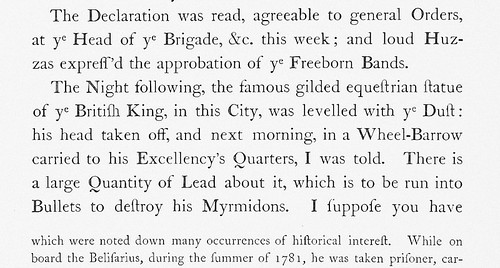
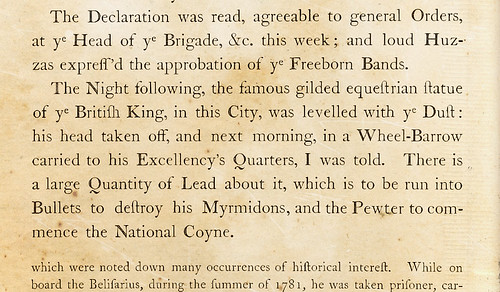
To read the earlier E-Sylum articles, see:
Regarding translations of the 1785 German sale of a Continental Dollar, Martin writes: "Attempts to read the "f" in "fl" as a "long s" or "pr" as "geprägt" (struck) don't really work, unfortunately. The first can be ruled out by comparing matching letters in the same document, and a Google search will bring up examples of both "pr" and "per" in older texts containing amounts in florins. "No matter which way I look at it, I can't get any further than "struck in tin (i.e. pewter in this case) per [at a rate of] 5 gulden" - but what that actually *means* is still uncertain. Most likely is that the pewter coins cost 5 fl. each to make, or that was their issue price. A much longer shot would be a reference to the grade of the pewter - "struck in pewter which costs 5 fl. for a standard unit weight", whatever that might have been - as opposed to any cheaper or more costly grade of metal, for example." Martin also provided a longer and more detailed discussion, which I've forwarded to Julia Casey. Thank you! -Editor
To read the earlier E-Sylum articles, see:
Regarding last week's article on the 600-piece Roman denarii hoard found in Bulgaria, Arthur Shippee writes:
To read the earlier E-Sylum article, see:
Gil Parsons writes:
"At times, his interest in art and design was entwined with his official position. From 1952 to 1999, he was the president of the Royal Mint Advisory Committee, where he helped oversee the designs for coins, seals, and medals, and was instrumental in the launch of a newly designed coinage released in 1952, produced to mark the beginning of the queen's reign."" Thank you - I wasn't aware of that numismatic connection. -Editor
To read the complete article, see:
David Pickup passed along this Royal Mint page for the 2017 Prince Philip coins, which also mentions his services on the Royal Mint Advisory Committee . Thanks. -Editor 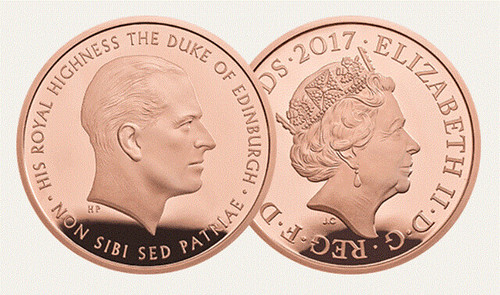
His Royal Highness The Prince Philip, Duke of Edinburgh retired from public engagements in the summer of 2017 at the age of 96. Beginning with service in the navy in 1939, through his steadfast support of Her Majesty The Queen as the longest serving consort and his leadership of hundreds of charities, Prince Philip's record of service and achievement is unlikely to be equalled. As he reflects on nearly 80 years of service, this is also a significant moment for The Royal Mint, as The Duke of Edinburgh served as President of The Royal Mint Advisory Committee from 1952 until 1999.
For more information, or to order, see:
John Phipps writes: "As a non-numismatic corollary to your comment, "Considering that no one seems to be able to read an analog clock dial anymore, I'm not surprised. The same generational effect was likely present after the widespread adoption of mechanical clocks. "Kids these days, can't even read a simple sundial..."
To read the earlier E-Sylum article, see:
Dave Lange writes: "The name Harry Lelande rang a bell for me, and I intended to send the below image last week but got too busy to do so. It's taken from the back of a J. Oberwise & Company coin board from the early 1940s and lists a coin guide book for sale. Given the difference in spelling it may be that there's no relationship between Harry Lelande and James L. Lelonde; I wasn't able to find any connection on Ancestry.com. Even so, I thought it an interesting coincidence that they were both involved in numismatics." 
Thanks. I'd never seen nor heard of Lalonde's Lincoln Cent catalog. Does anyone have one in their library? -Editor
To read the earlier E-Sylum article, see:
Levin Messick writes:
"As far as the current crazed prices are concerned I was reminded of that old saying "A fool and his money are soon parted". I would advise any of our readers who might be thinking about investing to read about Tulipmania in "Extraordinary Popular Delusions and the Madness of Crowds" which brings up another old saying- "There is nothing new under the sun". "Finally, while I am bringing up historic sayings it occurs to me that we may have opened a new "Pandora's Box" and "we should be careful what we wish for because we just might get it and not like it when we do" I won't even go into the tax and counterfeiting issues that bitcoin raises for our Federales to ponder. "PS- The "Dutch" still grow tulips but no one pays a million guilders for one now days!"
To read the earlier E-Sylum articles, see:
Jonas Denenberg writes: "I'm looking for a Santamaria, Rome auction catalog from 1939. None have been digitized but one sold at auction for 100 Pounds. Might you have one at any chance?" I don't have the catalog - most of mine are sales of U.S. coins. Jonas is researching the provenance of a coin he recently purchased. Here's a summary of what he learned from the seller:
Can anyone help? -Editor 
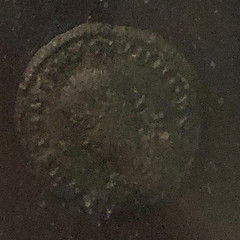
Ken Spindler writes:
Reporters have a miserable job. They're measured by quantity of product, not quality. They publish something that looks OK and move on quickly to something else. I have the same pressure every week, but I welcome the chance to set the record straight. I didn't notice that part of the article. I certainly agree that coins from the 1700s are not ancient, but in the eyes of the general public, that's how they seem. Here's an excerpt of Ken's Letter to the Editor of his local paper. -Editor The reference to 17th-century coins in the article title and article text ... as "ancient" is historically inaccurate. A coin would have to be over 1000 years older than any of the coins involved to be "ancient." Coins stolen from seafarers in 1695 or thereabouts were just contemporary circulating coins, not ancient ones! Why would commoners be holding ancient coins? The ancient world ended at the end of the eastern Roman Empire. After that period of world history, came the medieval period ("Middle Ages"). A 17th century coin is simply a 17th century coin. It's not even very old, by numismatic standards, except to novices. The Islamic and Spanish coins in the photo are most likely very common, and probably worth no more than a few dollars each, now. And in the 1700s only the silver or gold content mattered, not whatever image or text was stamped on the coin. Silver coins, no matter how strange looking, would be accepted for their weight in silver. It's still an interesting story when coins surface so far from their point of origin, but the inclusion of the word "pirate" is likely what turned an otherwise normal article into the clickbait phenom that took the story viral last week. The publicity netted Jim Bailey an interview yesterday with National Public Radio's Scott Simon, replete with Pirate jokes (and the "ancient" word, unfortunately). But it ended well, I thought. -Editor SIMON: You are a metal detectorist. BAILEY: That's correct. SIMON: Treasure hunter. Yeah. BAILEY: Well, you know, it's funny. The term treasure hunter makes it sound like I'm also, you know, searching out Bigfoot on the weekends. And we're not really looking for treasure. We're looking for history. It's not so much the artifacts. It's the story it tells, you know, and a story that reveals the unwritten chapter behind one of the greatest piracies that's ever took place. SIMON: Jim Bailey is a metal detectorist and scalawag in Rhode Island. I say that with respect. Thanks so much for being with us, sir.
To read the complete article, see:
To read the earlier E-Sylum article, see:
 Jim Contursi writes:
Jim Contursi writes:
"I'm fairly certain that the legend on the Siege of Peking Boxer Rebellion medal – mene mene tekel upharsin –is a transliteration of (Biblical) Aramaic, not Hebrew. " Thanks. -Editor
To read the earlier E-Sylum article, see:
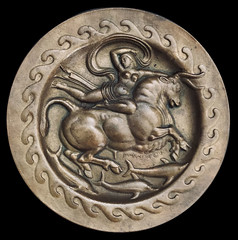 Harry Waterson writes:
Harry Waterson writes:
"This is just a short note of pure envy. I should be able to describe a medal like Bob Mueller. But I can't and I bemoan that." Many thanks for Bob for his excellent article on the works of artist Paul Manship last week. -Editor
To read the earlier E-Sylum article, see:

Wayne Homren, Editor The Numismatic Bibliomania Society is a non-profit organization promoting numismatic literature. See our web site at coinbooks.org. To submit items for publication in The E-Sylum, write to the Editor at this address: whomren@gmail.com To subscribe go to: https://my.binhost.com/lists/listinfo/esylum All Rights Reserved. NBS Home Page Contact the NBS webmaster 
|
